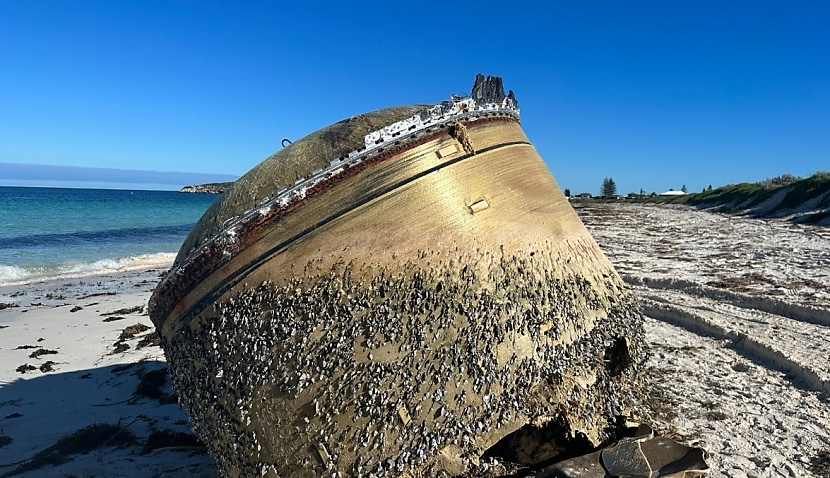
In a statement released on Monday night, the Australian Space Agency (ASA) urged the public to “avoid handling” the object and added it was “liaising with its global counterparts” to obtain more information.
The bizarre structure, found on Sunday at Green Head, 250 kilometres north of Perth, made global headlines upon its discovery.
It’s reported to be gold-coloured, 2.5 metres wide, and between 2.5 metres and 3 metres long, while the discovery has now been reported by the UK’s The Daily Telegraph and the US’ The New York Times.
“We are currently making enquiries related to this object located on a beach near Jurien Bay in Western Australia,” said ASA in a tweet.
“The object could be from a foreign space launch vehicle and we are liaising with global counterparts who may be able to provide more information.
“As the origin of the object is unknown, the community should avoid handling or attempting to move the object. If the community spot any further suspected debris, they should report it to local authorities and notify the Australian Space Agency via [email protected].
“We are committed to the long-term sustainability of outer space activities, including debris mitigation, and continue to highlight this on the international stage.”
The cylinder is now being guarded by Western Australia police, who believe it didn’t originate from a commercial aircraft as was previously speculated.
It comes after resident Garth Griffiths told the ABC a neighbour told him about the find on Sunday afternoon.
“Sometime yesterday, a local lady and her partner discovered it just floating on the edge of the water and dragged it out with their four-wheel drive,” he said.
“It’s a sort of semi-cylindrical object, made of light carbon fibre material like lightweight resin.
“[It’s] sort of 2.5 metres across by 2.5 to 3 metres long.”
The new discovery follows a spate of space junk being discovered scattered in a line in rural NSW last year.
Two of the pieces were later confirmed to belong to a SpaceX mission that re-entered the atmosphere over Australia in July last year, bringing with it a sonic boom that residents across the Snowy Mountains region reported hearing.
SpaceX followed up by sending a team in August last year to visit the sites where the debris was found.

Adam Thorn
Adam is a journalist who has worked for more than 40 prestigious media brands in the UK and Australia. Since 2005, his varied career has included stints as a reporter, copy editor, feature writer and editor for publications as diverse as Fleet Street newspaper The Sunday Times, fashion bible Jones, media and marketing website Mumbrella as well as lifestyle magazines such as GQ, Woman’s Weekly, Men’s Health and Loaded. He joined Momentum Media in early 2020 and currently writes for Australian Aviation and World of Aviation.
Receive the latest developments and updates on Australia’s space industry direct to your inbox. Subscribe today to Space Connect here.









